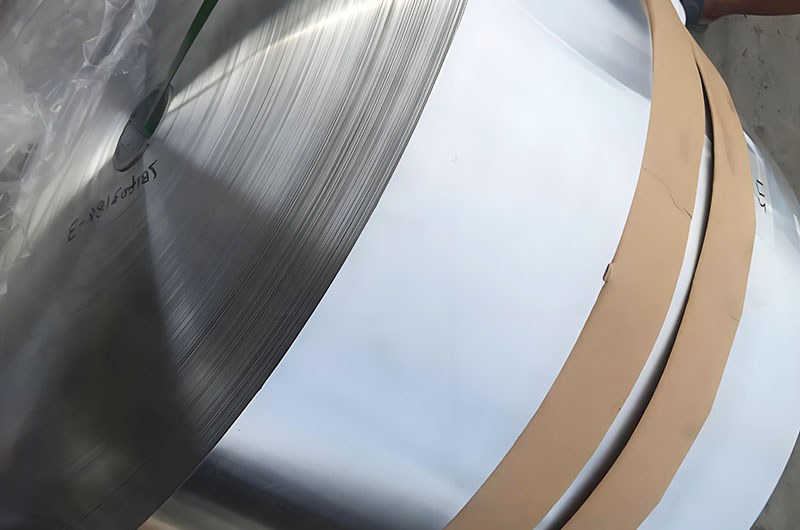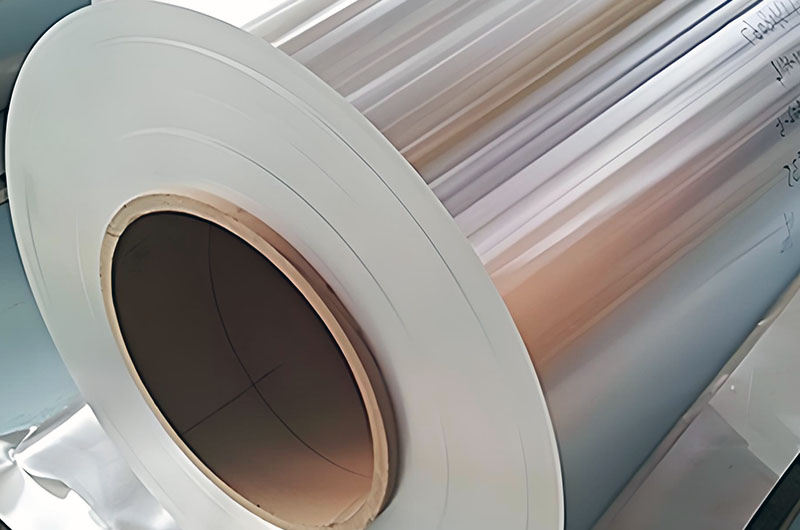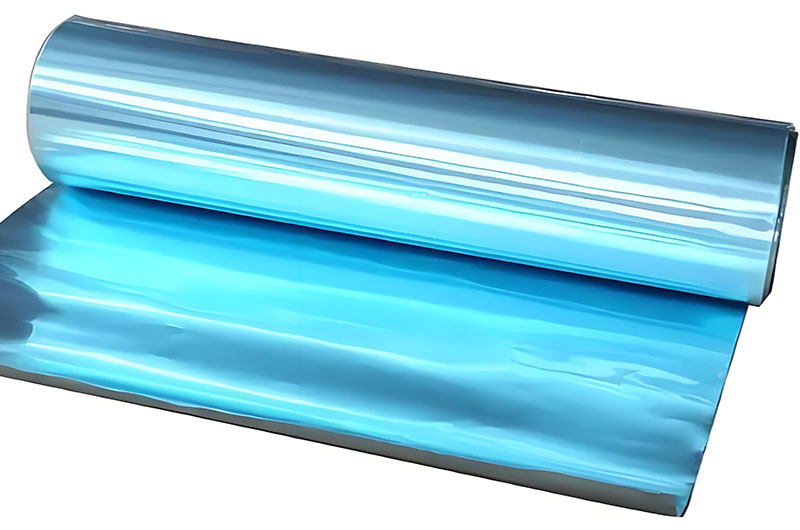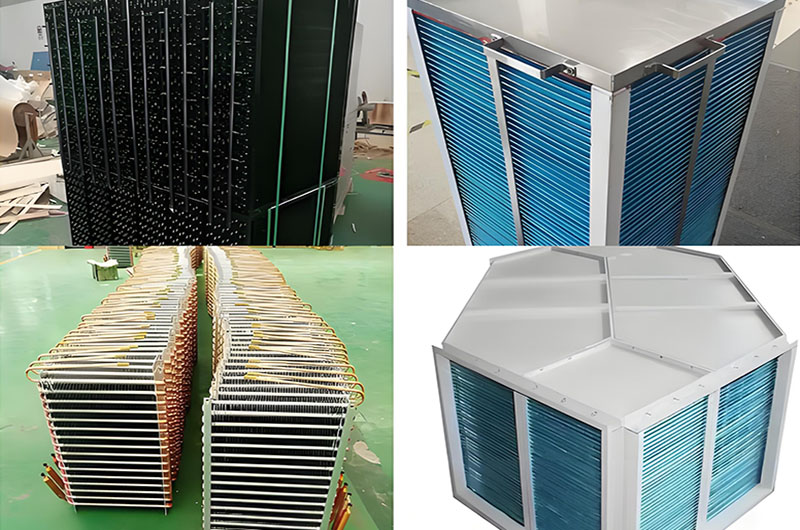Aluminum foil plays a crucial role in the efficiency and performance of air conditioning systems, primarily as the material for heat exchanger fins. Its excellent thermal conductivity, light weight, and versatility make it an ideal choice for enhancing the heat exchange process inside air conditioning units.
With its unique properties, aluminum foil plays a significant role in improving the efficiency and functionality of air conditioning (AC) systems.
Aluminum foil, in conjunction with copper tubes as heat exchange fins, directly affects the heat exchange efficiency and energy consumption of air conditioning units. For example, hydrophilic aluminum foil, with a surface coating, allows condensate water to flow off quickly, preventing water droplets from blocking air ducts and improving heat exchange efficiency by 5%.

Aluminum foil plays an important role in air conditioning systems. Air conditioner aluminum foil is mainly used in heat exchange equipment and has advantages such as good coating performance, high adhesion, good hydrophilicity, and excellent corrosion resistance. In addition, aluminum foil is often used to wrap air conditioning coils, thereby improving their efficiency and lifespan.
As a professional manufacturer of aluminum foil for air conditioning, Haomei Aluminum offers a range of high-quality products, including hydrophilic aluminum foil, hydrophobic aluminum foil, coated aluminum foil, fin materials, HVAC (Heating, Ventilation, and Air Conditioning) system aluminum tube, and air conditioning duct insulation tape, among others. We are dedicated to providing exceptional performance and high reliability solutions for air conditioner manufacturers, ensuring they meet the various demands of the industry.
Aluminum Foil for Air Conditioner Functions
Preventing Air Leakage
- Function: Aluminum foil acts as a barrier to prevent air from leaking out of the ducts, maintaining airtightness.
- Advantage: Reduces the loss of cold or hot air, lowering energy consumption.
Insulating Ducts
- Function: Aluminum foil insulates the ducts in the air conditioning system, blocking heat transfer.
- Advantage: Maintains the temperature inside the ducts, reduces energy loss, and improves system efficiency.
Enhancing Heat Transfer Efficiency
- Function: Wrapping the air conditioning coils enhances the transfer of heat.
- Advantage: Improves the working efficiency of the air conditioning system and extends the equipment's lifespan.
Improving Humidity Control
- Function: Controls the humidity levels within the air conditioning system.
- Advantage: Optimizes the performance of the air conditioning system.
Haomei Aluminum Foil for Air Conditioner Specification
| Product Name | Air Conditioner Aluminum Foil |
| Alloy | 1100 1200 3102 8011 |
| Temper | H22 H24 H26 |
| Thickness | 0.02-0.05mm |
| Width | 200-1450mm |
| Length/Weight | Customized |
| Inner Diameter | 76mm or 152mm |
As a leading air conditioner aluminum foil manufacturer, Haomei Aluminum offers a variety of high-quality products, including hydrophilic aluminum foil, hydrophobic aluminum foil, coated aluminum foil, fin stock, HVAC system aluminum foil tubes, and air duct insulation tape.

Features of Air Conditioning Aluminum Foil
| Feature | Description |
| High Reflectivity | Air conditioning aluminum foil has a reflectivity of up to 95%-97%, effectively reflecting radiant heat, reducing heat loss, and improving energy efficiency, helping the air conditioning system run more energy-efficiently. |
| Lightweight and Flexible | Air conditioning aluminum foil is lightweight and flexible, making it easy to mold around pipes, tubes, and various irregularly shaped surfaces, adapting to different design requirements and providing efficient air conditioning solutions. |
| Corrosion Resistant | Air conditioning aluminum foil possesses excellent corrosion resistance, withstanding long-term humidity and temperature fluctuations, resisting moisture and chemical corrosion, ensuring long-term stable and durable performance for the air conditioning system. |
| Non-toxic and Fireproof | Air conditioning aluminum foil complies with fire safety standards, is non-toxic, and non-combustible, making it suitable for use in residential and commercial air conditioning systems, reducing fire hazards and ensuring user safety. |
Haomei air conditioner aluminum foil product quality
At Haomei Aluminum, we are always committed to providing high-quality aluminum foil products, especially in the field of air conditioning aluminum foil. Our aluminum foils are well-formed, with a smooth surface free from defects like pinholes, scratches, dents, oil stains, dust, and other impurities, ensuring stable quality for every roll of aluminum foil and meeting strict usage standards. The foil thickness is consistent, ensuring optimal performance in every part of the air conditioning system.
The aluminum foil we produce features high strength, good ductility, and excellent corrosion resistance, particularly excelling in resistance to alkalis, salt fog, and humidity. These characteristics ensure that our aluminum foil provides lasting stability in various environmental conditions, meeting the long-term usage needs of air conditioning systems.
Our hydrophilic aluminum foil specially uses advanced coating technology to ensure that the foil exhibits excellent hydrophilic properties when exposed to moisture. After environmental testing, the hydrophilicity increased from an initial a<100 to a<250, further improving heat exchange efficiency and ensuring stable operation of air conditioning equipment in high-humidity environments.
In addition, coated aluminum foil has strong adhesion and uniform thickness, effectively enhancing its corrosion resistance and preventing the external environment from negatively affecting the air conditioning system, thus improving the longevity and reliability of the equipment. We believe that with our high-quality aluminum foil, we can provide customers with more efficient and durable air conditioning solutions.
Types of Aluminum Foil Used in Air Conditioning
Uncoated air conditioner aluminum foil
Uncoated aluminum foil, which has only undergone rolling and annealing treatment, was once widely used for air conditioning heat exchanger fins but has weaker corrosion resistance and hydrophilic properties.
Coated Aluminum Foil for Air Conditioner
- Hydrophilic Aluminum Foil: The surface is coated with a hydrophilic layer, which reduces the formation of water bridges and has both corrosion and mold resistance functions, such as Midea's "Ultra-Pure Gold Fins" and Hitachi's "Multi-Layer Blue Fins."
- Other Functional Coatings: These include corrosion resistance, hydrophobic, and self-lubricating types, meeting the demands for high performance and long service life in air conditioning systems.
Bare Aluminum Foil for Air Conditioning
Uncoated aluminum foil, without any surface treatment, is rolled and annealed to provide good mechanical properties and adequate corrosion resistance. This aluminum foil is commonly used for heat exchanger and condenser components in air conditioning systems due to its excellent thermal conductivity. The rolling and annealing processes make the foil surface smooth and easy to form into various shapes, meeting the needs for heat dissipation and heat exchange in air conditioning equipment.
- Application: Commonly used for heat exchangers and evaporators in standard indoor environments.
- Advantages: Cost-effective and simple manufacturing process.
- Limitations: Limited protection against corrosion and moisture, which may affect heat exchange efficiency over time.
Hydrophilic Aluminum Foil for Air Conditioning
Hydrophilic aluminum foil is aluminum foil treated with a special coating that enhances its moisture absorption capacity. This foil is commonly used in heat exchangers and condensers in air conditioning systems to increase water absorption, allowing condensate to spread quickly during condensation, improving heat exchange efficiency. With the coating, hydrophilic aluminum foil can better interact with water vapor in the air, improving the overall cooling effect.
- Application: Suitable for evaporator and condenser fins, aiding efficient condensation and moisture removal.
- Advantages: Increases heat exchange efficiency by preventing water retention between the heat exchange fins, thereby improving cooling performance.

Hydrophobic Aluminum Foil for Air Conditioning
Hydrophobic aluminum foil undergoes special coating treatment, making its surface water-resistant. This coating allows water droplets to form on the foil surface and slide off easily, preventing excessive moisture buildup on the heat exchanger surface and reducing condensate accumulation. This type of foil is widely used in air conditioning systems' evaporators and cooling systems to maintain high heat dissipation performance during long-term use and to prevent moisture-related corrosion and other issues.
- Application: Suitable for condenser and evaporator fins, where preventing water buildup is crucial.
- Advantages: Improves heat exchange efficiency by reducing moisture retention, enhancing overall system performance.
Corrosion-Resistant Aluminum Foil for Air Conditioning
Corrosion-resistant aluminum foil undergoes coating treatment to form an effective corrosion protection layer on the surface, making the aluminum foil resistant to corrosion caused by moisture and chemicals in the air. This type of foil is especially suitable for long-term use in air conditioning equipment, effectively extending the service life of the equipment and reducing maintenance costs. It is commonly used in air conditioning components exposed to high humidity and corrosive environments, such as condensers and evaporators, ensuring that the equipment maintains high performance even under extreme conditions.
- Application: Used in air conditioning systems exposed to harsh conditions, such as high humidity and high salt exposure in coastal areas.
- Advantages: Extends the service life of air conditioning components by preventing performance degradation due to corrosion.
Benefits of Using Aluminum Foil in Air Conditioning Systems
- Enhanced heat transfer: The high aluminum thermal conductivity helps in effective heat exchange, which is crucial for efficient cooling and heating. It reduces heat gain/loss, lowering HVAC workload and energy consumption.
- Condensation control: Prevents moisture accumulation on cold surfaces, reducing the risk of mold and deterioration of component performance.
- Lightweight design: The low density of aluminum contributes to the overall lightweight design of the air conditioning unit without compromising strength.
- Corrosion resistance: Properly coated aluminum foil offers corrosion resistance, ensuring longevity and reliable performance under various environmental conditions.
- Moisture management: Hydrophilic and hydrophobic coatings on aluminum foil help control condensation and prevent water accumulation that could affect performance or cause damage.
- Cost-effective: Affordable material with long-lasting performance, helping minimize maintenance costs.
Air Conditioner Aluminum Foil Color Selection
The color selection of aluminum foil used in air conditioners is not just for aesthetic purposes; it has a significant impact on the system's performance, durability, and efficiency. Different colors correspond to different surface treatments and coatings, each with unique functional advantages.
- Silver (Uncoated) Air Conditioner Aluminum Foil: Uncoated aluminum foil retains its natural metallic silver color. It is commonly used in budget-friendly air conditioners for components like evaporators, condensers, and fins. However, its corrosion and moisture protection is limited, typically requiring additional treatments.
- Blue (Hydrophilic Coating) Air Conditioner Aluminum Foil: Blue aluminum foil has a hydrophilic (water-attracting) coating that improves heat exchange efficiency by promoting the diffusion of condensation water on the coil surface. The coating prevents water droplets from accumulating, reduces scaling, and improves cooling performance. It is widely used in air conditioner evaporators and condensers.
- Gold (Corrosion-resistant Coating) Air Conditioner Aluminum Foil: Gold aluminum foil is treated with a special coating that enhances corrosion resistance, making it suitable for high-end air conditioner condensers and heat exchangers. This coating protects against moisture, salt, and other corrosive substances, extending the air conditioning system's lifespan.
- Black (Epoxy Resin Coating) Air Conditioner Aluminum Foil: Black-coated aluminum foil is primarily used for UV resistance and corrosion protection, especially in high-temperature environments or outdoor air conditioning units. The black epoxy resin coating provides an extra defense layer against environmental factors, ensuring durability and consistent performance.
How to Choose Air Conditioner Aluminum Foil Color
Choosing the right aluminum foil color for air conditioning is not just about visual preference; it directly impacts the system's efficiency, durability, and maintenance requirements. Blue and gold foils are popular due to their functional advantages in heat exchange and corrosion resistance. When selecting aluminum foil for air conditioning applications, consider the specific environmental conditions and performance needs to ensure optimal operation and longevity.
| Coating Type | Color | Functional Description |
| Hydrophilic Coating | Blue | Enhances heat exchange efficiency by improving water droplet diffusion, reducing scaling, and keeping the heat exchanger surface clean. |
| Corrosion-resistant Coating | Gold | Provides excellent protection against environmental factors, extending system lifespan and maintaining performance under harsh conditions. |
| Epoxy Resin Coating | Black | Provides UV resistance and additional corrosion protection, essential for outdoor units exposed to varying weather conditions. |
Haomei Popular Air Conditioner Foil Aluminum Alloy Series
8011 O H22 H24 Air Conditioner Aluminum Foil
8011 aluminum foil is known for its excellent corrosion resistance and strength. It comes in various tempers, such as O (soft), H22, and H24, which indicate different levels of hardness and strength.
Applications of 8011 Air Conditioner Aluminum Foil
- Heat Exchangers: Used in the production of heat exchanger fins due to its excellent thermal conductivity and corrosion resistance.
- Evaporators: Used for evaporator fins, ensuring efficient heat exchange and durability.
3102 H26 Aluminum Foil for Air Conditioners
3102 aluminum foil is known for its strength and corrosion resistance, with the H26 temper indicating high strength.
Applications of 3102 Air Conditioner Aluminum Foil
- Condensers: Used for fins in air conditioner condensers, enhancing heat efficiency and durability.
- Evaporators: Also used for evaporator fins, ensuring effective heat exchange and resistance to environmental factors.
8006 O H22 Aluminum Foil for Air Conditioners
8006 aluminum foil is often used in applications requiring good formability and heat resistance. O temper: Soft and elastic, suitable for applications that require easy bending and forming. H22 temper: Provides higher strength, suitable for more demanding applications.
Applications of 8006 Air Conditioner Aluminum Foil
- Tubes and Connectors: Used in the manufacturing of tubes and connectors in air conditioning systems, with good ductility and flexibility.
- Heat Exchanger Fins: Used in the production of fins, ensuring good flexibility and thermal performance.
1100/1200 Air Conditioner Aluminum Foil
1100 and 1200 aluminum foil are known for their excellent corrosion resistance and good thermal conductivity. These grades are commonly used in applications requiring high ductility.
Applications of 1100 and 1200 Aluminum Foil in Air Conditioners
- Heat Exchangers: Used in heat exchangers due to their excellent thermal conductivity and corrosion resistance.
- Insulation: Used in various insulation applications due to their flexibility and resistance to environmental factors.
4343/3003/4045 Composite Aluminum Foil
4343/3003/4045 Composite Aluminum Foil combines different aluminum alloys to enhance performance characteristics. Typically, 4343, 3003, and 4045 alloys are used in layers to optimize thermal conductivity, strength, and corrosion resistance.
Applications of 4343/3003/4045 Air Conditioner Aluminum Foil
- Heat Exchanger Fins: Composite aluminum foil is used for heat exchanger fins due to its excellent thermal performance and ease of fabrication.
- Cooling Devices: Suitable for general air conditioning radiators and cooling devices due to its good weldability and corrosion resistance.
Air Conditioner Aluminum Foil Mechanical Properties
| Alloy | Temper | Thickness(Mm) | Width (Mm) | I.D.(Mm) | Mechanical Properties | ||
| Tensile Strength (Mpa) | Elongation(%) | Erichson (IE, Mm | |||||
| 1100 1200 3102 8011 8006 | O | 0.08-0.2 (+/-5%) | 100-1400 (+/-1) | 75/150/ 200/300/505 | 80-110 | ≥27 | ≥6.0 |
| H22 | 100-135 | ≥22 | ≥5.5 | ||||
| H24 | 115-145 | ≥20 | ≥5.0 | ||||
| H26 | 125-160 | ≥10 | ≥4.5 | ||||
| H18 | ≥160 | ≥1 | – | ||||
| Special Specifications Can Be Produced As Per Customer’s Requirements | |||||||
Air Conditioner Aluminum Foil Chemical Composition
| Alloy | Si | Fe | Cu | Mn | Mg | Cr | Zn | Ni | Ti | Other | Al | |
| Each | Total | |||||||||||
| AA1200 | 1.00 | 0.05 | 0.05 | – | – | 0.10 | 0.05 | 0.05 | 0.15 | 99.00 | ||
| AA3102 | 0.40 | 0.70 | 0.10 | 0.05-0.4 | – | – | 0.30 | 0.10 | 0.05 | 0.15 | Rest | |
| AA8011 | 0.5-0.9 | 0.6-1.0 | 0.10 | 0.20 | 0.05 | 0.05 | – | 0.10 | 0.08 | 0.15 | Rest | |
| AA8006 | 0.40 | 1.2-2.0 | 0.30 | 0.3-1.0 | 0.10 | – | 0.10 | 0.10 | 0.05 | 0.05 | 0.15 | Rest |
Advantages of Haomei Air Conditioning Aluminum Foil
Excellent Aluminum Foil Shape and Surface Quality
- Stable shape: The aluminum foil maintains good shape, with no pinholes, scratches, dents, oil stains, or dust impurities on the surface.
- Uniform thickness: Ensures consistent thickness of each roll of aluminum foil, guaranteeing uniformity during processing and use.
Excellent Performance
- Good ductility: Able to meet processing requirements of different shapes and sizes.
- Excellent corrosion resistance: Includes resistance to alkali, salt spray corrosion, and humidity, ensuring long-term use in various environmental conditions.
Advantages of Coated Aluminum Foil
- Strong adhesion: The coated aluminum foil has excellent adhesion, ensuring that the coating does not easily fall off.
- Uniform thickness: The coating thickness is consistent, providing stable performance.
- Good corrosion resistance: The coated aluminum foil exhibits excellent corrosion resistance in various environments, extending its service life.
Note: The excellent hydrophilicity of hydrophilic aluminum foil: The initial hydrophilicity is a < 100, and after environmental testing, the hydrophilicity remains a < 250, ensuring effectiveness and reliability in humid environments.
Application of Haomei Aluminum Foil in Air Conditioner System
Aluminum foil enhances air conditioning systems by addressing radiant heat transfer, sealing leaks, and protecting components. Its integration with insulation systems and ductwork highlights its crucial role in optimizing energy efficiency and lifespan.

Air Conditioner Fins
Air conditioner fins are typically designed from aluminum foil in flat or corrugated shapes. Aluminum fins not only have excellent thermal conductivity but also effectively resist corrosion, ensuring long-term stable operation. They significantly improve heat exchange efficiency, ensuring efficient operation of air conditioning equipment.
Air Conditioner Evaporators and Condensers
Evaporator coil fins significantly increase the surface area of the evaporator coils, helping to enhance the heat transfer between the refrigerant and the surrounding air.
Condenser coil fins, similar to evaporators, increase the surface area of the condenser coils exposed to the surrounding air. This helps to efficiently dissipate the heat from the hot refrigerant into the environment, thus improving cooling efficiency and increasing system stability.
Pipe Insulation
Aluminum foil surface insulation is commonly used in HVAC duct systems. Aluminum foil acts as a radiant barrier, reflecting heat away from the ducts. This prevents heat exchange between the air inside the ducts, which has been conditioned, and the warmer external environment, thus maintaining the cool air temperature during transit.
Aluminum foil is often used in combination with fiberglass or foam, addressing radiant heat issues, while the core material handles conductive heat loss.
Refrigerant Line Protection
Aluminum foil-backed insulation sleeves wrap copper refrigerant lines. The aluminum foil layer reflects ambient heat, minimizing energy loss and preventing condensation. This ensures efficient heat transfer within the system.
Sealing with Aluminum Foil Tape
Aluminum foil tape is used to seal pipe joints and seams. It is durable, moisture-resistant, and heat-stable, ensuring an airtight system and preventing energy leakage.
Component Protection
During manufacturing or installation, aluminum foil can protect sensitive components from moisture, dust, or mechanical damage due to its corrosion resistance.
Aluminum foil is indispensable in air conditioning manufacturing, providing customized solutions to address various performance and environmental challenges. Choosing the right type of aluminum foil based on alloy composition, coating, and treatment is crucial for optimizing the efficiency, durability, and overall performance of air conditioning systems.
Common Questions about Air Conditioning Aluminum Foil
What are the hydrophilic and hydrophobic coatings on aluminum foil?
Hydrophilic coating makes aluminum foil absorbent, aiding in heat transfer and moisture control. Hydrophobic coating repels water, preventing the aluminum foil from absorbing moisture and promoting the formation of water droplets.
What are the advantages of hydrophilic aluminum foil in air conditioning systems?
Hydrophilic foil can enhance heat transfer efficiency, improve dehumidification performance, and prevent corrosion of fins and coils.
How should hydrophilic and hydrophobic coatings be maintained?
Hydrophilic and hydrophobic coatings may wear off over time due to environmental factors. Regular inspection and re-coating may be required as necessary.
Can aluminum foil from old air conditioning components be recycled?
Yes, aluminum foil from old air conditioning components can be recycled. Aluminum has a high recycling rate and can be used to produce new aluminum foil and other aluminum products.
